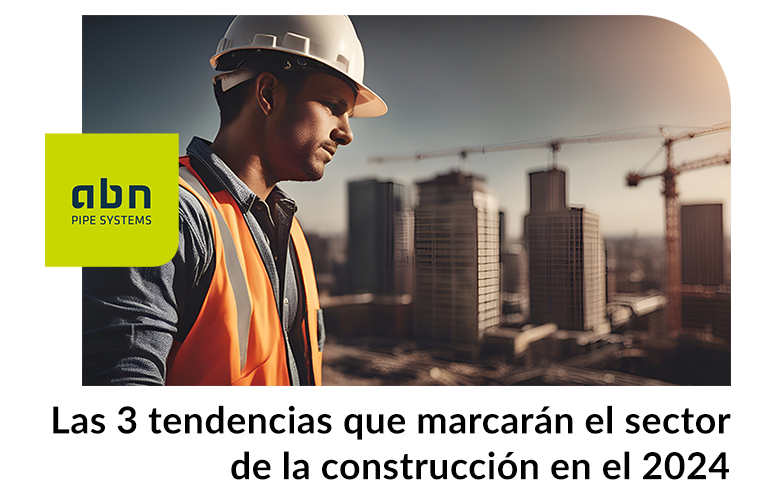En el transcurso del 2023, la industria de la construcción se enfrentó a diferentes desafíos, entre ellos, las interrupciones en la cadena de suministro, el aumento de los costes de materiales o la escasez de mano de obra. Sin embargo, el espíritu resiliente e innovador de los profesionales de la construcción prevalece en este 2024.
Este sector se encuentra en proceso de incorporar innovadoras tecnologías y persiste en su camino hacia prácticas más sostenibles, lo que modificará significativamente la manera en que llevamos a cabo la construcción.
A continuación, exploraremos las tendencias más destacadas que marcarán el futuro del sector de la construcción.
- Innovaciones tecnológicas en el sector de la construcción
- Humanización de la construcción
- Sostenibilidad y eficiencia energética
Innovaciones tecnológicas en el sector de la construcción
El sector de la construcción está experimentando una revolución gracias a tecnologías como la Realidad Aumentada y el uso de drones, mejorando la eficiencia en la planificación, ejecución y mantenimiento de proyectos.
Una visión al detalle con la Realidad Aumentada y el uso de drones
La incorporación de la Realidad Aumentada proporciona una visión detallada de los proyectos ayudando a mejorar la eficiencia tanto en la construcción como en el mantenimiento. También el uso de drones está revolucionando la forma en la que se llevan a cabo los análisis de construcción y las inspecciones, mejorando la seguridad y la eficiencia en el proceso constructivo.
Combinadas con una comunicación en tiempo real, estas herramientas facilitan la colaboración entre los operadores de oficina y el campo de trabajo, haciendo más fácil la toma de decisiones.
Eficiencia en el manejo de datos con la Inteligencia Artificial
La combinación de inteligencia artificial (IA) y datos está liderando la revolución en la industria de la construcción.
Utilizando la IA para la recopilación de datos, las empresas pueden lograr una mayor eficiencia en los proyectos ya que permite llevar a cabo análisis de rendimiento en tiempo real, impulsar la automatización de tareas y fomentar el desarrollo sostenible en el ámbito de la construcción.
Además, este enfoque de trabajo allana el terreno para la creación de entornos de datos compartidos gracias a las plataformas de datos conectados. Estas permiten una mayor eficiencia, agilidad en la resolución de problemas y la toma de decisiones informadas.
BIM: El estándar en la planificación y ejecución de las construcciones
BIM (Building Information Modeling) se ha consolidado como una metodología esencial para planificar y ejecutar proyectos arquitectónicos. Este estándar tiene la capacidad de proporcionar un modelado 3D detallado y simular variables que afectan la estructura.
Además, su función para gestionar datos a lo largo del ciclo de vida del proyecto, desde la planificación hasta el mantenimiento, la convierte en un componente esencial para el sector.
Humanización de la construcción
La construcción del futuro no solo se trata de erigir estructuras impresionantes, sino de crear entornos que realmente mejoren la calidad de vida de las personas. En este contexto, la humanización de la construcción emerge como una poderosa tendencia que coloca a las personas y su bienestar en el epicentro del diseño arquitectónico y la planificación urbana.
Construcción en bloques, la construcción modular
La construcción modular o prefabricada implica la cimentación de secciones de la construcción lejos del lugar de obra, en entornos controlados, para luego transportarlas e instalarlas en el sitio final.
Se caracteriza por su rapidez de producción, la estandarización del proceso y la ausencia de impacto climático, que hace que este tipo de edificación sea ideal para proyectos de gran envergadura, como hoteles, hospitales y residencias.
Una construcción natural a través del diseño biofílico
El diseño biofílico busca la conexión de la naturaleza con el bienestar físico y mental a través de la incorporación de vegetación en las edificaciones, esto ayuda a reducir los efectos del cambio climático, además de contribuir al aislamiento térmico y acústico.
Ejemplos como el diseño para la entrada de luz natural o las fachadas cubiertas por vegetación, junto con la creación de espacios al aire libre, promueven el confort y ayudan a reducir el estrés.
Sostenibilidad y eficiencia energética
La conciencia medioambiental sigue siendo una prioridad en el 2024. El uso de materiales sostenibles, el diseño eficiente en términos de energía y la integración de tecnologías verdes, siguen siendo un esencial a la hora de diseñar los nuevos proyectos de construcción.
Conservando el patrimonio
La renovación de edificios se ha convertido en un arte que fusiona la historia con la modernidad. En lugar de demoler estructuras antiguas, los arquitectos y diseñadores están adoptando un enfoque de respeto hacia el patrimonio arquitectónico. La restauración de fachadas, la conservación de elementos históricos y la adaptación de espacios para cumplir con estándares contemporáneos son prácticas comunes que permiten que el pasado cobre vida de una manera sostenible.
Eficiencia Energética y Ahorro
El 2024 ha dado paso a una revolución en la forma en que concebimos la eficiencia energética, destacando las «Passive Houses» como líderes en esta tendencia. Estas viviendas, especialmente prominentes en el norte de Europa, son ejemplos concretos de cómo la construcción puede ser amigable con el medio ambiente y económicamente eficiente.
Al no depender de fuentes externas para calefacción o refrigeración, estas casas aprovechan el clima local y la ubicación geográfica para lograr un ahorro significativo en los costos de energía.
Próximamente en el sector de la construcción
Este recorrido por las tendencias del 2024 revela una transformación en la manera en la que concebimos y construimos nuestros espacios.
En la intersección entre la tradición y la vanguardia, la construcción del futuro se teje con hilos de sostenibilidad, tecnología y una conexión con las necesidades humanas. Nos encontramos frente a un compromiso constante con la adaptación y la información, en un horizonte donde la construcción no solo es técnica, si no al servicio de los humanos.
